The concept of Retro Rewind is revisiting films I saw as a teenager in the late ‘80s and early ‘90s and viewing them again now through the eyes of a 40-something horror fan in the current era. A lot has changed since the 1980s and 1990s. I’ll comment along the way on how society has changed and how our perception of these films and the monsters within may have changed over time. The films also influence us and our perceptions and imaginings. Tonight’s selection was Return of the Living Dead (1985).
When you think of the word “zombie,” what do you envision? Do you see a rotting corpse on the prowl for “braaaaiiiiiiiiins?” That’s what most of us see, thanks to Return of the Living Dead. But it wasn’t always this way!

Webster’s Dictionary describes a zombie as “a will-less and speechless human (as in voodoo belief and in fictional stories) held to have died and been supernaturally reanimated.” Zombies appear in literature as early as 1818 when Mary Shelly wrote Frankenstein. Although the creature did not stalk living people to eat their brains, he was fashioned from dead bodies and was reanimated by science.
Prior to Return of the Living Dead, the popular cultural concept of a Zombie was very different. Edgar Allen Poe had an impact on the genre, writing tales such as “Ligeia,” “The Fall of the House of Usher,” and “The Facts in the Case of M. Valdemar.” Poe conceptualized reanimated dead in his stories. In M. Valdemar, Poe described a man who had been hypnotized as he was dying. The body remained in a state of preservation for seven months and then he was awakened. At that time he began to decompose and transforms into a “detestable putrescence.”
Before Return of the Living Dead, Zombies Were Different
Look back to Bela Lugosi in White Zombie. This film influenced the name of a metal band and a craft beer, and it was also the first feature-length zombie film. Those zombies were not brain-eating rotting corpses either. They were dead people reanimated for manual labor. This concept of the zombie aligns with Haitian folklore. Those tales involve people being transformed by magical spells or potions into a compliant body to do someone’s bidding. If you said the word “Zombie” to a person in 1932 or the 1800s they might not know what you are talking about. They might also envision a compliant, blank-faced person, eyes staring but seeing nothing. I Walked with a Zombie (1943) continued with White Zombie themes.

Night of the Living Dead (1968) brought us reanimated dead bodies that ate human flesh. Fans later used the word “Zombie,” but the term was not used in the film. Instead of poisons or magic, radiation from a space probe returning to Earth was the source of reanimation. Those zombies did eat human flesh, but not specifically brains. They lumbered about slowly and seemingly aimlessly. They zoned in on human beings, motivated by hunger. They could be killed if their brains were destroyed.
Dawn of the Dead updated the zombie subgenre, but the zombies were not self-aware and did not communicate. Those creatures shuffled aimlessly and did not move quickly. They also did not eat brains exclusively but were still dangerous.
Return of the Living Dead Changed Everything!
When you think of the word “zombie,” likely you are thinking of a mobile corpse calling for braaaaiiiiiiiiins. That imagery comes directly from this film. The film showed us a lot of firsts. The zombies run instead of lumbering slowly, and they run fast! They flood in after police and paramedics and devour any humans unlucky enough to be in their path. No more aimless and wandering, these zombies can chase down their prey.
In addition to speed, Return of the Living Dead zombies are capable of articulating their thoughts, sensations, and feelings. They can reason and plan ahead, as two of the zombies gain access to police and EMT radios to request more cops and paramedics after they killed the first wave of responders. One of the characters cremates himself after becoming a zombie rather than exist in that state. Another newly-turned zombie expresses love for his girlfriend while trying to access her to eat her brains. Was he manipulating her for her brains?
The main characters accidentally capture one of the creatures and question her. This memorable scene is a film first since to the zombie articulates her thoughts and feelings. The characters are horrified as she explains the hunger for brains. This scene is unsettling as the zombie explains that being dead is painful—she can feel herself rot, and eating brains gives respite from the pain.

Also, the special effects were practical effects, which we need to appreciate since the crew did not have access to CGI.
Return of the Living Dead Edited for TV…
I first saw this movie circa 1989. A friend taped it from a cable channel. When I viewed the film this time around, I noticed I had seen a different version due to editing. Foul language and nudity were absent from the first version I saw. I had watched Night of the Living Dead before, and I expected more of the slow-moving variety of zombies. I was in for a surprise. Return of the Living Dead zombies could move fast and overtake their human prey. Also, these Return of the Living Dead zombies were nearly impossible to kill. That made it scary, in my opinion. Things that won’t die are scary.
Speaking of scary things, during my recent screening, I noticed the mortician’s character appears to be an aging Nazi. This flew over my radar when I was a younger viewer. There were WWII-era Nazis still alive in 1985, and they could be hiding anywhere. The mortician could have been in his ’60s, which would fit the profile. According to NPR, the last known WWII Nazi living in the US was deported to Germany in 2018 and died at age 95. The Nazi in the film aligns himself with the good guys, and at the end of the film, he pulls one of the younger characters into the attic in an attempt to rescue both of them. The film hinted at his villainous past but allowed him to try to be a decent human in the end.
The Naked Zombie…
I definitely did not remember Trash’s (Linea Quigley’s) naked graveyard dance from the prior viewing. The version I saw the first time around did not contain that performance. While I watched the dance, I wondered why Trash was wearing leg warmers in July. This character wasn’t a first, however, since there were other naked zombies in films before and since this film. I also noticed how the young people were main characters instead of peripheral characters, and some survive to the end of the movie.
Aside from fast-moving zombies craving brains, other themes from Return are still relevant. We are still talking about conspiracy theories about various news events and still speculating about coverups in the modern era. An undercurrent of ‘don’t trust the government,’ is still present. Disease or contagion causing the zombie crisis has been a theme in some subsequent films. Bearing in mind that we have spent the last 18 months fighting a worldwide contagion, some of the more recent films hit a bit close to reality. Years before the pandemic, The Center for Disease Control even ran a campaign about Zombie Preparedness.
I enjoyed this visit with the past. This film screams ‘80s, from the soundtrack to the kids’ clothing, and the gratuitous use of nudity. This was an enjoyable visit with the past. The next time you attend a Zombie 5k or compare notes about how you would survive the zombie apocalypse, just remember where the zombies you imagine originated.
….And protect your braaaaiiiiiiiiins!



